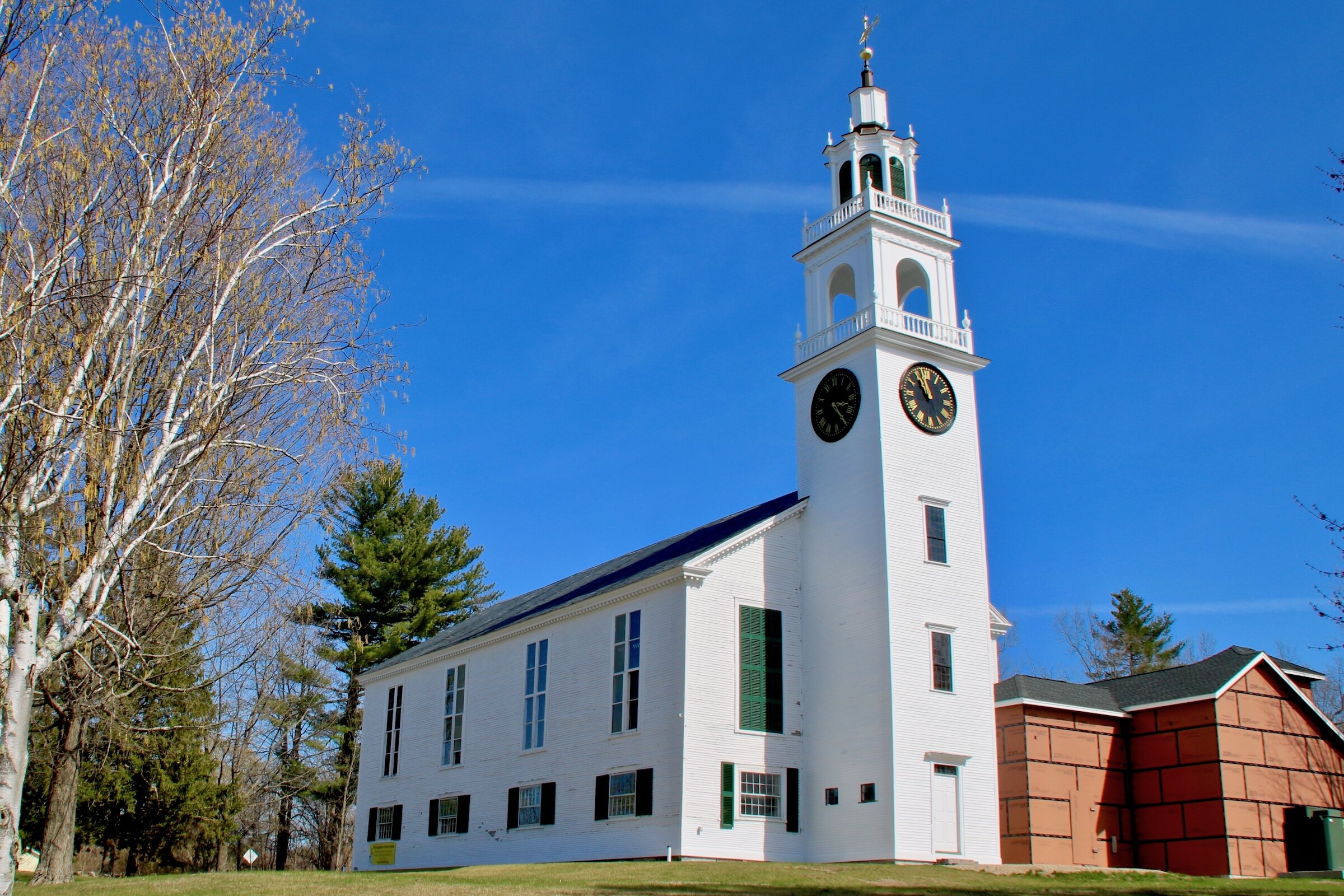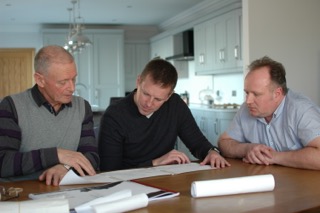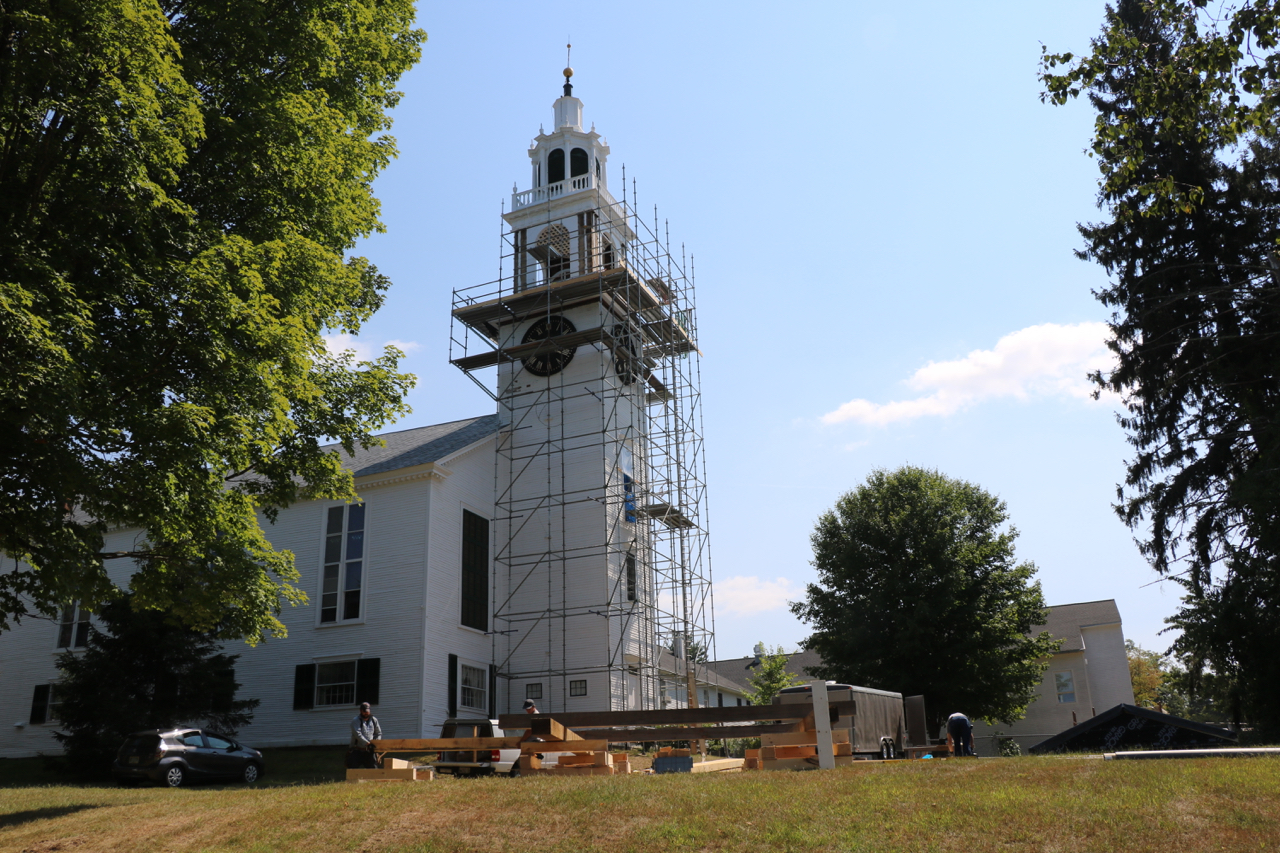
NUTFIELD HISTORY BLOG
Articles, news, and more
First Parish Preserves Historic East Derry Meetinghouse Steeple with Funding from LCHIP Grants
The $500K historic rehabilitation of the 1769 meetinghouse’s Tower and Steeple were recently completed by First Parish Church in East Derry, with funding help from two LCHIP grants.
East Derry, New Hampshire — The historic preservation team at First Parish Church is proud to announce the completion of a major phase in the multi-year rehabilitation of the church’s 1769 Meetinghouse: the repair and rebuilding of the Tower and Steeple.
The $500,000 project benefited from 2015 and 2017 grants by New Hampshire’s Land and Community Heritage Investment Program (LCHIP) totaling $155,000. The rest of the funding came from generous congregational and regional donations, which were catalyzed by the support of LCHIP and the state’s historic preservation community.
Preservation Timber Framing, Inc. of South Berwick, Maine was the primary contractor. Highlights of the large project include:
Removal of the bell and lowering of the unsafe Steeple to the ground in September 2015,
Removal of inappropriate 1990s steel beams and anchors inside the Tower,
Significant repairs to the Tower timber frame, including inserting two new 60’ tall white pine corner posts from above in November 2017,
Reconstruction of 95% of the Steeple—exactly replicating the original materials and elements while improving the internal timber frame—and lifting it back on top of the Tower in June 2019,
Application of extensive copper flashing and roofing (by The Heritage Company, E. Waterford, Maine) and refurbishing and re-gilding of the weathervane (by The Chester Gilder, Chester, New Hampshire), and
• Finishing external repairs, lead paint removal, and repainting in September 2019.
“As the continuous stewards of this community treasure since it was built in 1769 by Mathew Thornton and other early settlers, we at First Parish Church are thrilled to complete this next major step in the long effort to restore and prepare the Meetinghouse for another century of service to the church and the community,” said the Rev. Dr. Deborah Roof, senior pastor and teacher at First Parish.
“For nearly 30 years we’ve worked on historic churches, barns, community buildings, museums, homes, and more all over New England,” said Arron Sturgis, president of Preservation Timber Framing. “This Tower and Steeple project at First Parish stands out as one of the most challenging—but ultimately most satisfying—we’ve had the privilege to be part of.”
The unsafe Steeple was lowered to the ground Sept. 9, 2015.
Guiding a 60’ tall new corner post down into the Tower as a crane lowers it, Nov. 21, 2017.
Raising the restored Steeple, June 27, 2019.
About First Parish and the Meetinghouse Preservation Effort
First Parish Church was established in 1719 by Rev. James MacGregor, who led a group of Scots-Irish families from Northern Ireland to settle in the territory then known as Nutfield. The current Meetinghouse is the community’s second, and it has served both religious and civic functions continuously since its construction in 1769.
Learn more about First Parish Church at www.fpc-ucc.org.
The current historic preservation effort began with a formal study in 2012. It has seen the building raised five feet then lowered onto a new state-of-the-art foundation; the construction of an adjacent Accessibility Connector to hold an elevator serving both historic and modern buildings; numerous repairs to the timber frame, clapboards and trim; and the installation of a new, safer heating system.
Learn more about the rehab work at www.nutfieldhistory.org.
The church has invested about $1.6M so far. Initial funding came from years of donations by church members plus an internal capital campaign that raised $800,000 from the small but passionate congregation. Additional funds came from a loan with Enterprise Bank, and the successful LCHIP grants.
LCHIP grant recipients are required to at least match the grant amount dollar for dollar. Much of the matching funds for the Tower and Steeple work came from community donations through the Friends of the Meetinghouse at First Parish, a 501(c)(3) non-profit with responsibility for community fundraising.
Fundraising efforts are continuing, as the remaining work includes completion of the elevator and Connector building, rehabilitation of the upper-story Sanctuary, and the rebuilding of meeting rooms and more in the lower level.
Information on ways to donate and support this work is available at the Friends’ website, www.fotmh.org, or by emailing info@fotmh.org.
About New Hampshire’s Land and Community Heritage Investment Program
The New Hampshire Land and Community Heritage Investment Program is an independent state authority created by the legislature in 2000 with a legislative mandate to ensure the perpetual contribution of natural, cultural and historic resources to the economy, environment, and quality of life in New Hampshire.
LCHIP provides matching grants to New Hampshire communities and non-profits to conserve and preserve the state’s most important natural, cultural and historic resources., The program has provided 466 grants which have helped to conserve more than 290,000 acres of land for food production, water quality, ecological values, timber management and recreation and supported 280 projects to rehabilitate historic structures and sites.
Grants have been awarded in all parts of the state and in 167 of New Hampshire’s 234 communities. Forty-six million dollars of state money has led to a total project value of more than $317 million. The money for LCHIP grants comes from fees on four documents recorded at the Registry of Deeds in every county of the state.
For more information about LCHIP, visit LCHIP.org or call (603) 224-4113
###
Rehabilitated Tower an Steeple on the west end of the Meetinghouse; Accessibility Connector with elevator underway to the right, April 29, 2020.
Telling the Nutfield Story: Ulster-Scots Videos
Videos on the 1718 MIgration from Northern Ireland and the settlements of Nutfield in New Hampshire and near Portland in Maine.
The Nutfield 300th anniversary celebration isn’t just important to our towns of Londonderry, Derry, Windham and Derryfield, but also to those “back home” in Northern Ireland. Accordingly, this past August the Northern-Ireland based Ulster-Scots Agency invested considerable resources in sending a professional film crew over to capture scenes and interviews from old Nutfield and the similar early settlements in Maine (see blog post to the right).
The resulting video productions are available to watch below. These include:
an introduction to the project by Richard Hanna, Director of Education and Language for the Ulster-Scots Agency, Belfast, Northern Ireland,
a short piece focused on Rev. MacGregor’s establishment of Londonderry and Derry,
a broader look at the 1718 MIgration and journey of the Scots-Irish from Ulster to Nutfield and Maine, and
a comparison of the parallels—and differences–between Belfast Maine and Belfast Northern Ireland.
FIrst up is the brief introduction by RIchard Hanna.
This first video from the Nutfield and Northern Ireland collaboration starts with Rev. James MacGregor’s journey and ends showing the interior of a meetinghouse still very much like the original version of that at Rev. Macgregor’s First Parish in East Derry.
This next video covers the 1718 journey of Rev. MacGregor’s company from his home parish in Aghadowey Northern Ireland to New England, and their settlements in Nutfield and in Maine. It includes a sentiment expressed by our local TJ Cullinane on the challenges of the early settlers that applies well to our goals for the whole 300th celebration:
“[If} people today, so preoccupied with their own troubles, … would only look back into their own history, they’d see that what they’re contending with today pales in comparison with the trials and tribulations of the First Settlers. ”
This final video in the series focuses on Belfast Maine—founded by members of Rev. MacGregor’s contingent who journeyed north of New Hamshire and ended up staying—and its parallels with Belfast Northern Ireland.
We hope these videos have provided a bit of historical info and enthusiasm for the upcoming Nutfield 300th celebrations here in Derry, Londonderry, Windham, and the Derryfield portion of Manchester. Visit the Nutfield 300th Page to learn more, and follow the Nutfield 300th on Facebook for updates.
BBC Filming Rev. MacGregor's Story
A BBC film crew is covering a Rev. MacGregor family reunion and historic Nutfield sites on Saturday, March 3, 2018.
Rev. James MacGregor—“the Moses of the Scotch-Irish in America” —led the first of thousands of Scots who migrated from Northern Ireland to North America in the 1700s. Now some of his descendants are retracing Rev. MacGregor’s journey, in the company of a film crew making a documentary for the BBC.
This Saturday (March 3, 2018) they’ll be in Derry and East Derry, New Hampshire, the heart of the old Nutfield territory that Rev. MacGregor and the sixteen First Settler families made home.
Discovering A Famous Ancestor
Waddell Media, Ireland’s largest factual independent production company, is filming for the BBC Northern Ireland’s Family Footsteps series on living history and genealogy.
Rev. MacGregor descendent Alan Laughlin and son Ainsley with BBC presenter Gavin Andrews (center) study their long family tree.
They have already filmed retired Northern Ireland teacher Alan Laughlin taking a journey of discovery through his family tree, revealing how and where his Ulster-Scots ancestors lived during the 19th and 20th century, and ultimately revealing an ancestral link to Rev. MacGregor.
Alan’s son Ainsley is also part of the story. He, his wife Kerry, and their three daughters recently experienced the daily life of their ancestors at the Ulster Folk Park in Cultra, county Down. As described by Waddell production coordinator Sharon Whittaker, “Ainsley swapped software development for manual labour, Kerry the microwave for the open fire, and the girls got a taste of rural education in the 1800s.”
Now as this post is published, Alan and son Ainsley are traveling to New England with well-known BBC Northern Ireland presenter Gavin Andrews and a sizable film crew.
A recent depiction of Rev. MacGregor by Derry-area artist Rosalind Giuffrida Hartley.
Here the Laughlins will learn more about the legacy of of an ancestor whom prior to last week they didn’t even know they had. They will visit the port where MacGregor and his flock first landed, trace the settlers' path through New England, explore remnants of early settler life, and stop in Derry to see the legacy of the Nutfield settlement MacGregor helped establish and meet other MacGregor descendants.
Derry Locations
The filming will take place this Saturday, March 3rd, for most of the day. Area relative Colin Brooks will join Alan and Ainsley on the adventure. The film crew hopes to record key historic sites, and also to capture the look and feel of MacGregor’s town as it is today.
MacGregor family coat of arms window in the Derry Public Library (photo courtesy DPL).
The highlight is a surprise event for Alan and Ainsley: a 12:30 pm family reunion and luncheon reception for MacGregor descendants at the Derry Public Library. (Though not open to the public, the team is seeking additional MacGregor descendants to attend and meet Alan, Ainsley, and Colin. Please email if you’re interested. See also this story at Nutfield Geneology.)
The Derry Museum of History is downstairs in the Adams Memorial Building in downtown Derry, at 29 W. Broadway.
Earlier (about 11:00 am), the crew will arrive in Derry and be welcomed at the Adams Memorial Building by the Derry Heritage Commission. After a tour of the Derry Museum of History and its collection of MacGregor and Nutfield displays, the group will take a filming walk along Broadway to the Derry Public Library. They’ll shoot outside scenes of the library—which was first built thanks to the generosity of a MacGregor descendent—and the adjacent MacGregor Park, then join the reunion inside.
MacGregor memorial plaque at the Derry Public Library.
First Parish Church with its Meetinghouse anchoring the Upper Village, a National Register of Historic Sites location.
After, the crew will drive up the hill to the historic Upper Village in East Derry. About 3:00 pm the First Parish Historic Preservation Committee will give a tour of the 1769 Meetinghouse at First Parish Church, which is currently undergoing a massive historic preservation project. The Friends of the Forest Hill Cemetery will then host the crew’s visit to the First Settlers plots in the adjacent graveyard. (The public is welcome to observe at both sites.)
The First Settlers plot in Forest Hill Cemetery.
The day will then wrap with filming on Beaver Lake, near the site where MacGregor preached the First Sermon on April 12, 1719, marking the founding of Nutfield.
Depiction of the First Sermon on April 12, 1719, under an oak tree on the shore of Beaver Lake (from Willey's Book of Nutfield).
As our local preparations for the Nutfield 300th Anniversary Celebration ramp up, it’s exciting to see how important the story of Rev. MacGregor and Nutfield are to their descendants in Northern Ireland, and to participate by hosting this BBC filming. We will share news of the production and TV show as it develops.
First Parish Receives $59,000 LCHIP Grant for Meetinghouse Roof System Rehabilitation
The multi-year project to preserve the Meetinghouse at First Parish Church in East Derry wins its second NH state LCHIP grant: $59,000 towards Roof System Rehabilitation.
On December 8, 2016, New Hampshire's Land and Community Heritage Investment Program (LCHIP) announced that First Parish Church in East Derry is one of the awardees of a 2016 LCHIP grant award for historic preservation.
Governor Hassan and LCHIP Board Chair Doug Cole present the $59,000 grant award to Paul Lindemann on behalf of First Parish Church. (Photo credit: Perry Smith)
The grant is $59,000 towards the Meetinghouse Roof System Rehabilitation project. Planned for summer of 2017, this project entails repairing and strengthening the supporting roof structure, replacing damaged 1880's slate tiles as needed, and finishing the slate roof for another century of service to the community.
Gov. Hassan, LCHIP’s Executive Director Dijit Taylor, LCHIP Board Chair Doug Cole, and part of our team from First Parish: church member Bill Mann (left) and Arron Sturgis (right) of Preservation Timber Framing. (Photo credit: Perry Smith)
New Hampshire Governor Maggie Hassan and Senate President Chuck Morse joined together at the award ceremony to congratulate LCHIP’s most recent grant recipients on their hard work and successful efforts toward protecting the special places that define New Hampshire. Governor Hassan observed that:
"The Land and Community Heritage Investment Program is critical to protecting our natural, historical and cultural resources, and I am proud that we restored funding for LCHIP in 2013 and maintained that commitment in our current bipartisan budget. For every dollar invested by LCHIP, we see a significant return on investment through the economic activity generated by those conservation efforts. This year's grants will support important projects across the state that will preserve our natural beauty and protect our rich history and vibrant culture."
About the Roof System Rehab Project
When built in 1759, the Meetinghouse roof was no doubt covered with wooden shingles. These were likely placed with slates as part of the major renovations done in 1884 (when the stained glass windows were installed).
Today most for the original slates are present, and in good shape. The copper nails holding them, though, are not, and the underlying structure has suffered from carrying the extra weight.


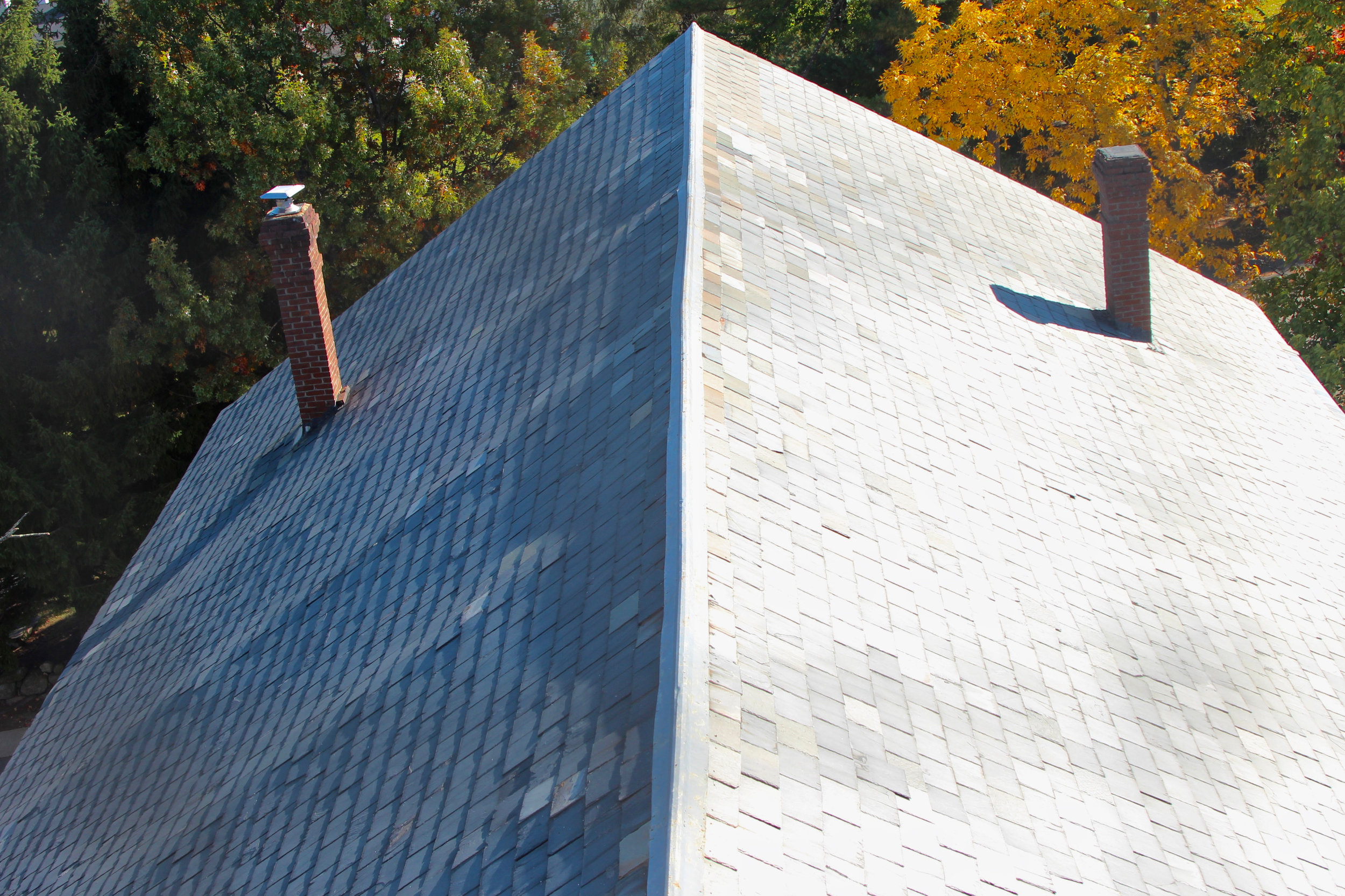
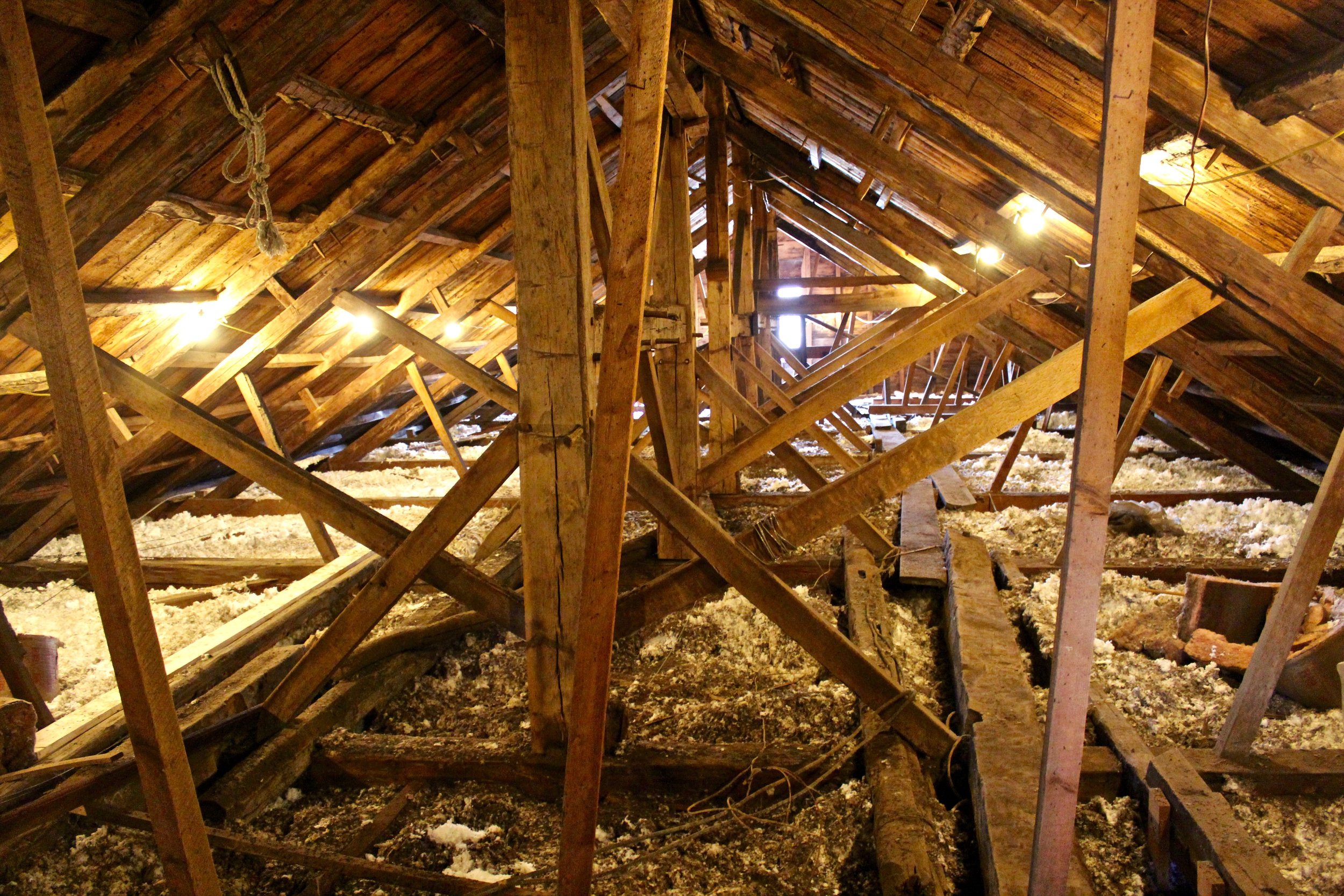
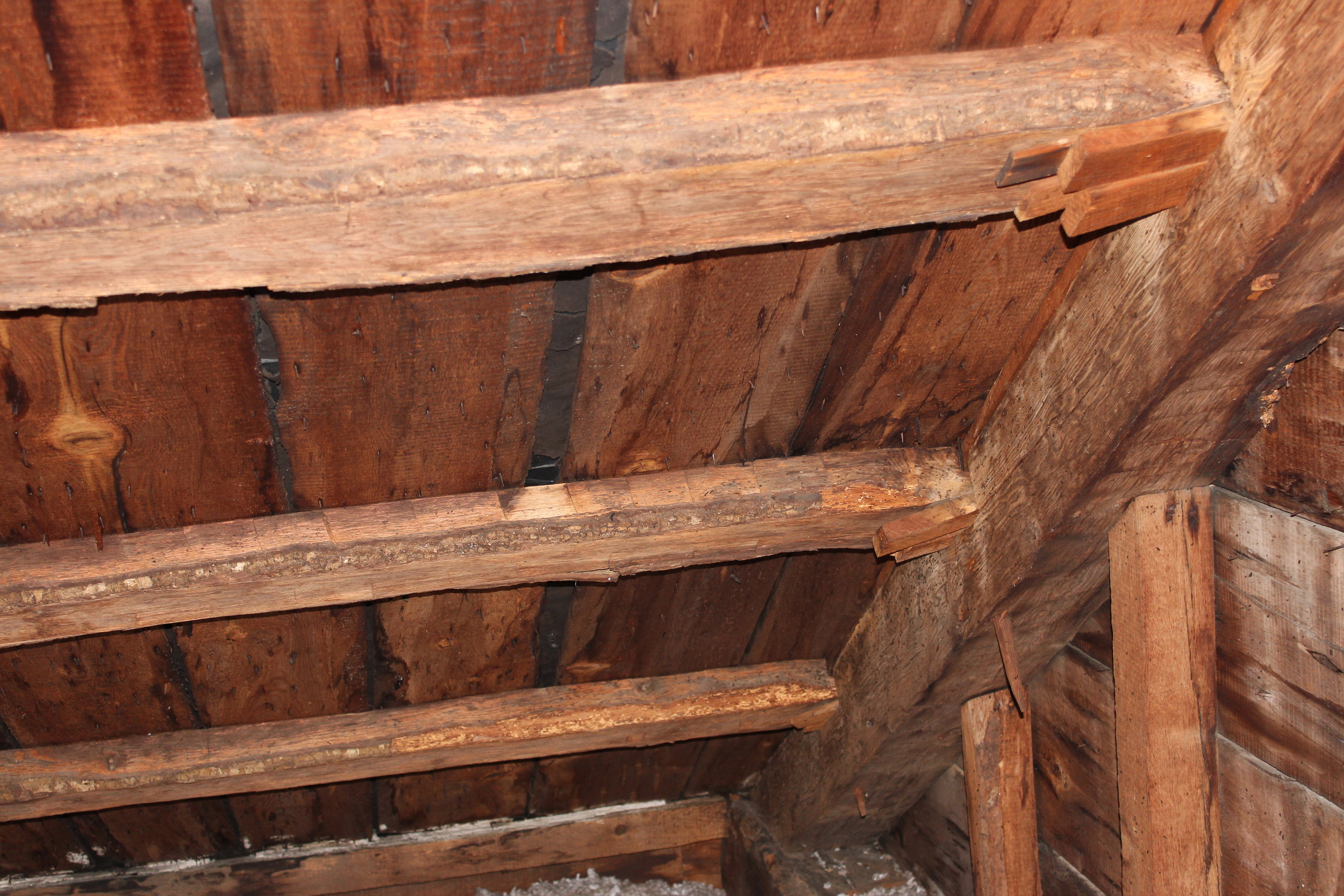

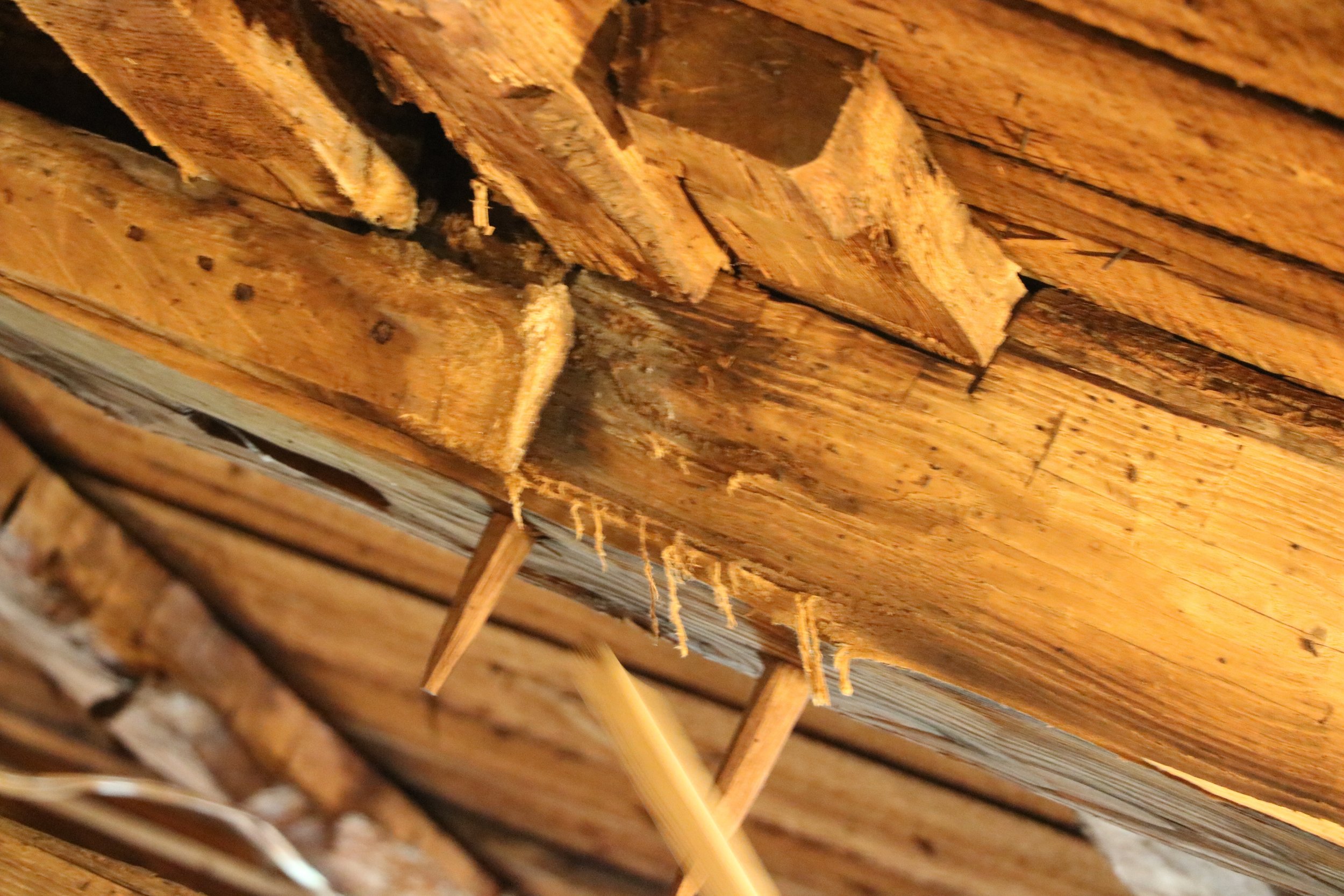
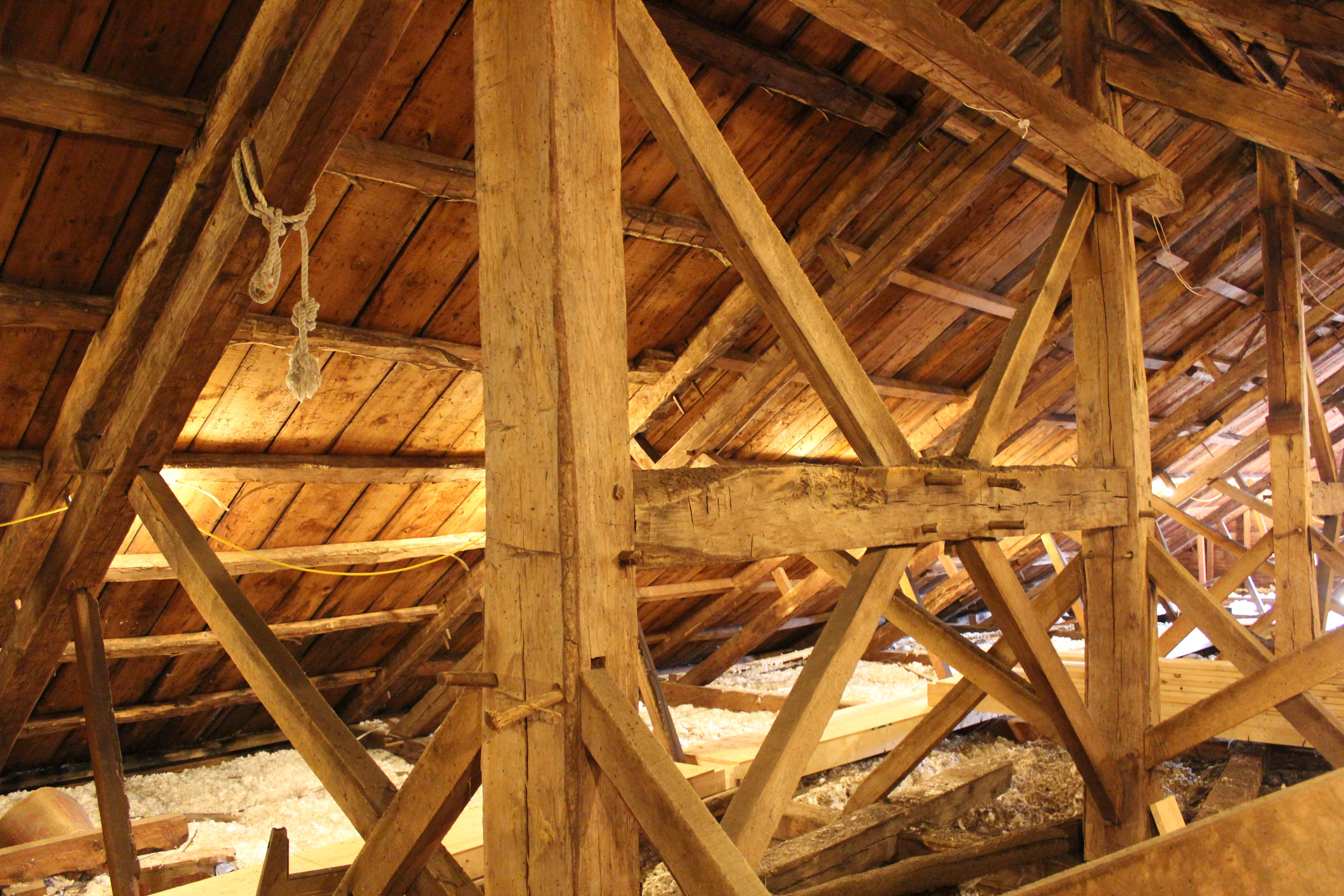
First Parish will execute the Roof System Rehab Project with expert partners Preservation Timber Framing. The work entails:
- Carefully removing the existing slates covering the roof.
- Repairing the board roof sheathing and underlying timber frame, and strengthening that frame to better handle the weight of the slates.
- Recovering the roof with the original slates plus replacement slates that match as necessary.
- Reinstalling or repairing the flashing, coping, and other roof details to ensure the roof is tight and waterproof.
First Parish is not just repairing the roof but rather executing a type of historic building preservation classified as rehabilitation by the Secretary of the Interior's Guidelines for the Treatment of Historic Properties. All work must be code-compliant yet historically-sensitive, and satisfy the applicable standards. For example:
- The existing original slate tiles will be reused as much as possible and carefully matched when not, so that the rehabilitated roof's slate exterior should look very much as it originally did (conforms to Standard #2).
- The original historic fabric of the roof structure will be absolutely preserved and retained, while the more modern additions of engineered lumber and metal connectors essential for code compliance will be easily distinguishable from the historic work, and straightforwardly reversible (Standards #2, 3, and 4).
- External trim and details along the roofline will be repaired if possible, or if necessary replaced in-kind with materials and methods similar to those used by the original builders (Standard #6).
The project is planned for the summer of 2017. The LCHIP award, however, is a matching grant, and so First Parish must raise the additional funds required for the project, $118,000.
This is the second LCHIP grant award First Parish has won for Meetinghouse rehabilitation. The first was $125,000 awarded in 2015 for the Meetinghouse Tower Rehabilitation Project.
About LCHIP and the 2016 Awards
The Meetinghouse Roof System Rehab project is one of thirty five awarded funding in LCHIP’s fifteenth grant round. supporting projects ranging from Northumberland in the North County to Nashua in the south and from Portsmouth in the east to Claremont in the west. The three and a half million dollars awarded by LCHIP are being matched by nearly $20,000,000 in funds from other sources.
Grant decisions are made by the 18-member LCHIP Board of Directors, following a rigorous months-long application and review process. “The LCHIP Board of Directors is always pleased to help with saving New Hampshire’s historic landmarks and landscapes” observed LCHIP Board Chairman Doug Cole or DS Cole Growers in Loudon. He continued: “It is great to see historic buildings rehabilitated to their original glory and contributing to the local economy again. Plus, since we all like to eat, protecting farmland is a good investment.”
The New Hampshire Land and Community Heritage Investment Program is an independent state authority that provides matching grants to New Hampshire communities and non-profits to protect and preserve the state’s most important natural, cultural and historic resources. Its legislatively mandated mission is to ensure the perpetual contribution of these resources to the economy, environment, and the quality of life in New Hampshire.
Since its inception in 2000, the program has provided 372 grants which have helped to protect nearly 200 historic structures and sites and to conserve more than 278,000 acres of land for food production, water quality, ecological values, timber management and recreation including hunting and fishing. Grants have been awarded in all parts of the state and in 149 of New Hampshire’s communities. Thirty-nine million dollars of state money have leveraged more than $244 million in funds from other sources. LCHIP grants are supported by fees on four documents recorded at the Registry of Deeds in every county of the state.
For more information about LCHIP, visit lchip.org or call (603)224-4113.
The Tower Top is Leaving the FPC Meetinghouse
FPC lowered the unsafe Meetinghouse Tower Top to the ground in September, where it provided an impressive view at the top of East Derry hill through the holidays. Now it is being dissembled and transported to keep it safer from the weather as it undergoes two years of repairs and restoration.
In the process of taking down the Tower Top last September, FPC's expert contractor Arron Sturgis of Preservation Timber Framing (PTF) discovered it had even more decay and damage than anticipated.
With Top firmly on the ground, further inspection led Arron to recommend that FPC dismantle and store the the lantern and belfry off-site. There were several good reasons for this, including:
- To avoid any further damage from the weather,
- To secure the valuable weathervane and bell, and
- To make repairs of the complex structure and intricate detail more efficiently in the shop.
FPC agreed, and the work for this subproject began with the new year.
Preparing for Dissasembly
Once the ground froze (very late this year), a rented four-wheel drive, diesel, "man lift" arrived to help the PTF team with their next tasks.
First they thoroughly documented the lantern and belfry with photographs, measurements and notes. Unlike a normal construction job where demolition is done as quickly as possible, in the "Rehabilitation" class of historic preservation FPC is pursuing here every original piece of wood will be either repaired and reused or replaced using the same species if possible. Most of the trim elements here are early Eastern White Pine, with white oak being used where needed for structural strength.
With documentation in hand, the team then carefully removed the weathervane, finials, railings, trim, and roofing, and determined the best cut lines to break the structure into pieces that will fit on a trailer.
They made a fascinating discovery along the way.
Identifying One Source of Damage
After removing the 1990's copper sheathing on the upper lantern roof, they found layers of wooden shingles and an oiled sailcloth covering. Underneath was a scrawled signature and date. The signature is so far illegible, but the date clearly reads "November 1916"!
Apparently at that time they modified the flatter original roof to achieve the more graceful curved line we're used to seeing. The sailcloth covering was an acceptable measure for its day, but required regular maintenance to remain watertight.
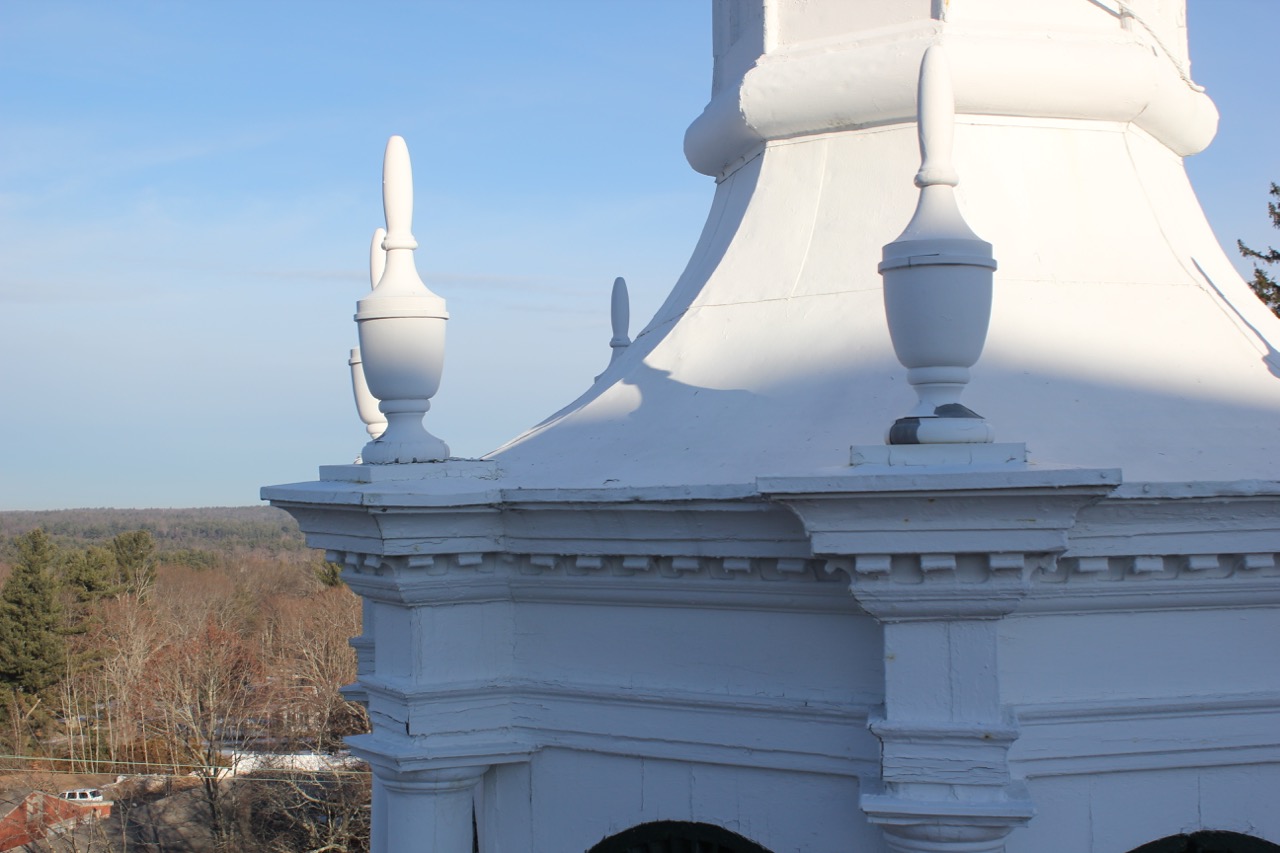
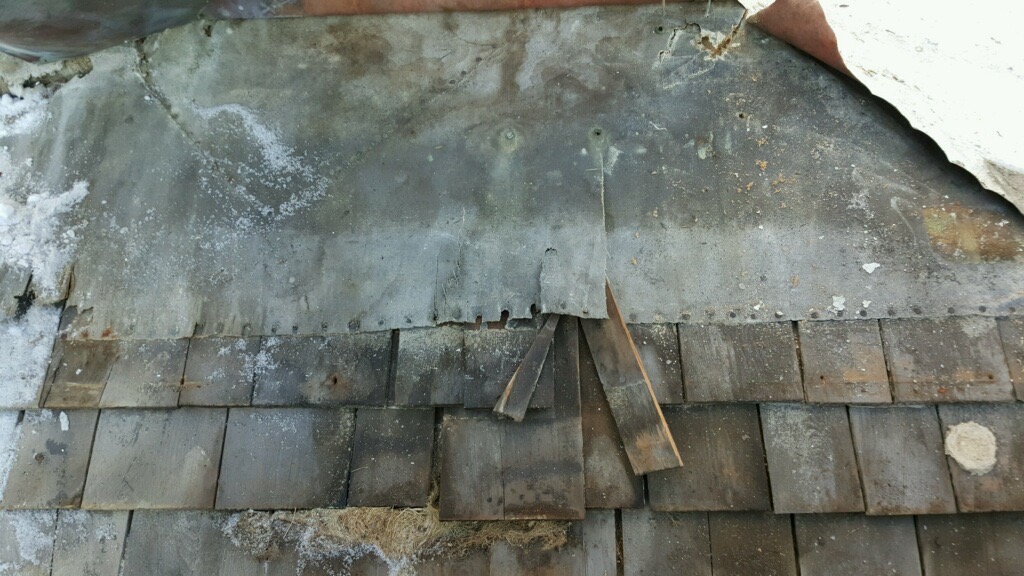
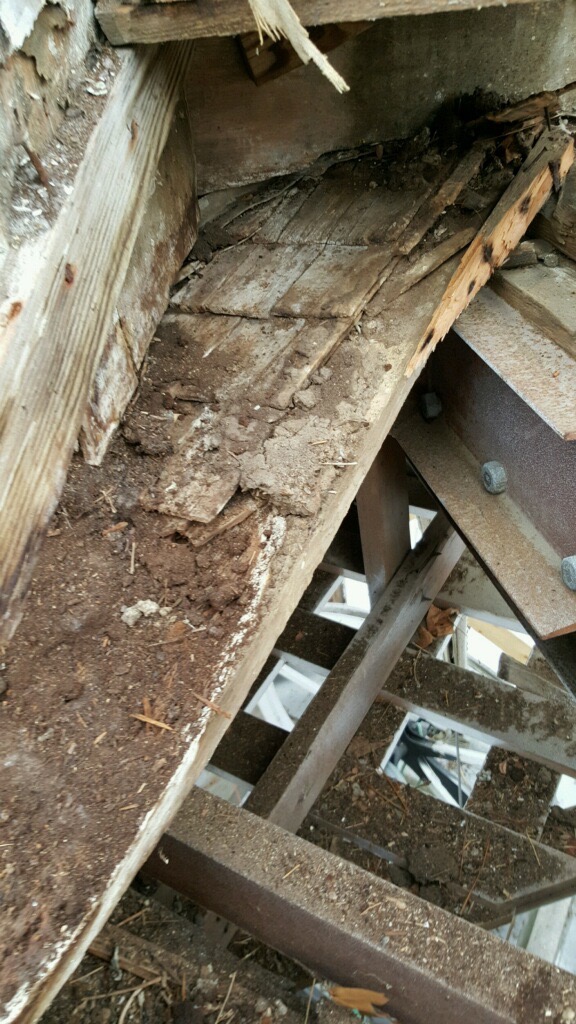
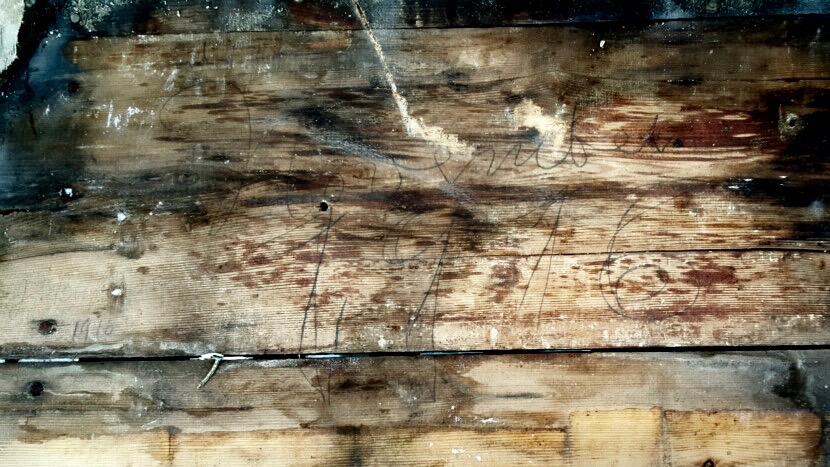
We know that the church was in severe financial trouble in at least the 1930s, so such maintenance was no doubt a very low priority. Water getting in through this roof (before the copper was applied) likely caused much of the internal lantern damage we see today.
Ready for Another Crane Day
As we write this post, the Lantern and Belfry are almost ready for disassembly and transport to their new temporary home.
A 30-ton crane—smaller than that used in September but still substantial!—is scheduled to do this job on Wednesday, January 20 (weather permitting).
The crew will execute the pre-calculated cuts to free the upper lantern, then break the lower lantern and belfry into smaller chunks. The 2,200 pound bell will also be lifted out, and with multiple trips everything will hopefully be delivered to the new site by the end of the day.
That new site is a a huge former lumber mill 35 minutes away in Nottingham, NH. There PTF has a large heated workshop and a much larger covered storage shed.
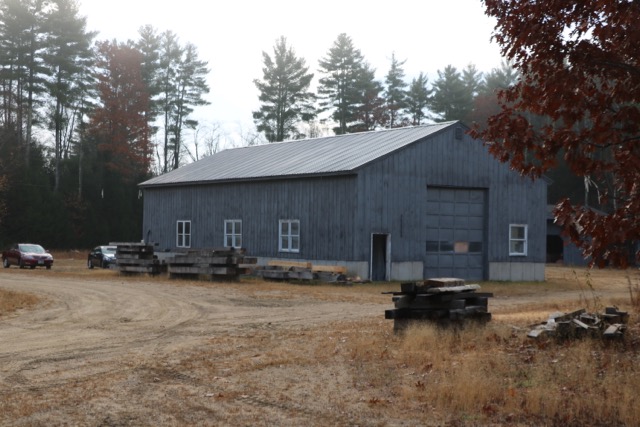
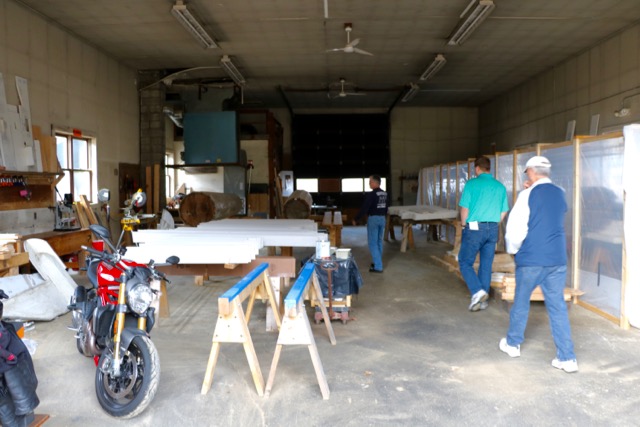
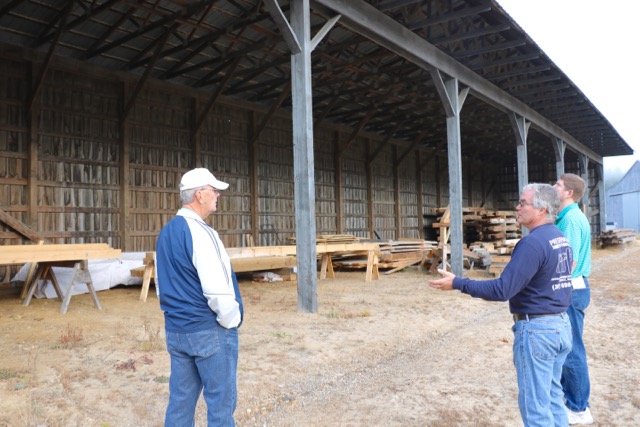
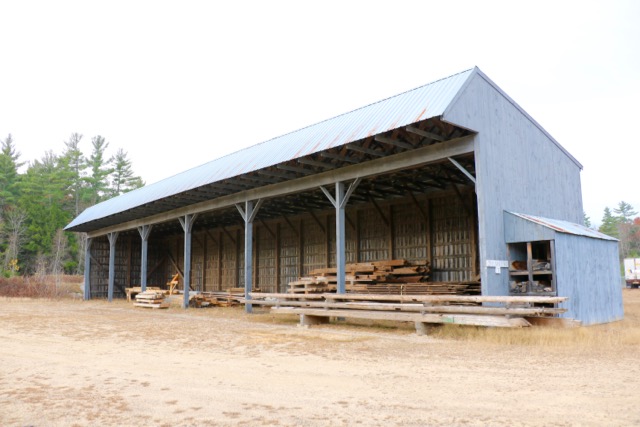
Two Years Away
Once in Nottingham, the Tower Top can be very carefully restored under excellent (warm!) conditions. There is no rush on this because other phases of the Meetinghouse Rehabilitation work must be completed before the Top can be replaced on the Tower.
Starting soon after this coming Easter in mid-April 2016, church services will switch from the Sanctuary in the Meetinghouse to the function hall in the modern Currier Building. Everything inside at risk from construction work will be moved or secured, and other preparations executed.
Then the Meetinghouse with the Tower base attached will be lifted several feet in the air.
The Meetinghouse floor is just slightly out of level.
Repairs and excavation will be done, and a cement foundation will replace the original granite blocks on rubble foundation we still see today. (A facade sliced from the current granite will cover all exposed cement.) The building will then be lowered, and experience a state of levelness it hasn't seen for several decades.
All the red and yellow timbers need repair or replacement.
In the next summer construction season starting Spring 2017, attention will be focused on rehabilitating the timber frame throughout the Meetinghouse, especially the roof and the west-end wall with attached Tower base. It's after that work is complete that the then-restored Tower Top can return for reassembly and lifting back in place.
Ringing the Bell Once Again
The Tower Top will have had quite an adventure, flying down in September 2015, majestically standing as a new mini-landmark through the holidays, moving to Nottingham in January 2016 for loving restoration, then finally retaking its lofty perch in probably August of 2017. There it will be ready for another century of unique and beautiful community service.
The poor structural state has kept FPC from ringing the Tower bell for several years now. Everyone is very much looking forward to that moment when it can loudly swing once again.
UPDATE – FPC Tower Takedown is Wed. Sept. 9
Some details on the Sept. 9th Tower Takedown, with photos from the site on Sept. 1st and 2nd.
September 2, 2015 – East Derry, New Hampshire — The removal of the damaged top of the First Parish Church Meetinghouse tower is now scheduled for:
Wednesday, Sept. 9, 2015, between 10:00 a.m. and 12:00 noon
The large crane will arrive Tuesday afternoon, and drive across the lawn to its position near the tower (special mats will help protect the grass). A trailer or two of counterweights will accompany the crane.
Preparations will begin early Wednesday morning with the lifting up of long bearing timbers (see photos below). These will rest on metal brackets attached to the belfry, and the Preservation Timber Framing (PTF) crew will through-bolt them to the belfry wall to support the top during the lift. The crane will be rigged to the timbers, and the top lifted off.
Because the belfry has long timber "legs" that nest down inside the tower base, the crane must actually lift it up very high. (The weathervane on top is firmly attached, and most likely will stay in place for the ride down.)
The crane will slowly lower the top down to timber cribbing waiting on the ground. The crew will attach side braces to safely hold the top in place while the crane still supports its weight. Once the top is secured to the cribbing on the ground, the crane will be released and move on to its next job.
That next job is to fly up the new roof that will seal the open top of the tower base. That roof is covered by a rubber membrane roofing material that will provide excellent weather protection for the two years it should take to return the restored top to the rehabilitated tower. (Batten strips on the roof surface, decorative gable/side panels, and other work will be done in time so that the roof looks a bit better than it does this week.)
After the new roof is flown up and secured, the crew may use the crane to remove the bell (which probably weighs about 1,200 pounds). This will depend on how much time is left in the day, and how quickly the tower top rigging can be changed for safe bell removal. If there's not enough time left, PTF will remove the bell another time (with a much smaller crane!).
Steeple Coming Down at First Parish Church in East Derry, New Hampshire
The Tower Top Takedown is Sept. 9, 10:00am–12:00 noon. Major rehab efforts on the FPC Meetinghouse get started in late August, 2015, with the takedown of the damaged top part of the tower.
UPDATE — Takedown Day is now scheduled for Wed. Sept. 9. The "flying down" of the tower top should be between 10:00am and 12:00 noon. See more updates on the Project Page.
Press Release – EAST DERRY, NH – August 13, 2015 – A very visible step in the effort to preserve a significant New Hampshire landmark will soon take place with the lowering of the steeple at First Parish Church (FPC) in East Derry.
On or about Wednesday, August 26, timber frame experts will make the final detachments and a large crane will lower to the ground the top two sections of the tower on the historic FPC Meetinghouse. The belfry and lantern will be placed in secured staging on the lawn, and a temporary roof will be lifted up and installed above the clock, which will remain in place.
It will take two years to complete the restoration work and reunite the top sections with the rest of the tower.
Rehabilitating an Historic Landmark
Built in 1769, with the current tower added in 1824, the timber frame Meetinghouse appears to be in remarkably good condition but actually needs an estimated $1.5–$2M in repairs. The tower structure is especially deteriorated, and the top sections must come down now before the weather potentially takes them down this winter.
This work on the tower is part of a multi-year effort to rehabilitate the historic Meetinghouse, ideally in time for the 300th anniversary of the church and Derry’s founding in 2019. Plans call for:
- Lifting the building to rebuild its foundation and adding an adjacent elevator for full accessibility throughout the facility in 2016,
- Repairing the timber frame and slate roof in 2017, and
- Restoring and rehabilitating the interior finishes in 2018.
“The meetinghouse at First Parish is one of the most beautiful and significant 18th century New Hampshire buildings still in active use. We applaud and support the church’s dedication and perseverance in beginning this rehab effort, and look forward to seeing their great results over the next three years.”
The tower top itself will be repaired and restored while on the ground, and be reunited with the rehabilitated tower base after the Meetinghouse foundation work is completed in the fall of 2017.
Initial funding for the Tower Takedown and early rehab projects comes from years of preservation donations and a recent $800,000 capital campaign drive within the church. A community-oriented fundraising effort launching soon and various grants will hopefully contribute towards the remaining costs; FPC has submitted a 2015 NH state LCHIP application to cover part of the $300,000 estimated cost of rehabilitating the tower alone.
“Our church has been a trustworthy steward of ‘The Old Meetinghouse on the Hill’ for two and a half centuries,” said the Rev. Dr. Deborah Roof, pastor of First Parish Church. “We look forward to sharing this rewarding challenge with the community through several dramatic rehabilitation projects that all begin now with taking down the damaged parts of the steeple.”
About the FPC Meetinghouse
“The First Parish Church Meetinghouse is one of the most significant and inspiring timber framed structures in New England. The peaceful removal of the damaged belfry and lantern frames from the tower begins a comprehensive and thoughtful preservation of the entire historic structure. We look forward to working closely with FPC as they ready the building for their 300th birthday in 2019.”
The current FPC Meetinghouse was constructed in 1769 to replace an earlier structure built by the area’s first settlers. It has served as a civic, community, and religious center for almost 250 years, and today is home to the vibrant First Parish Congregational Church UCC (United Church of Christ). Along with two modern FPC buildings, the Meetinghouse is host to concerts, social gatherings, history events, a preschool, and the regular meetings of dozens of community groups.
“The First Parish Church is the cornerstone of our towns founding. It stands high on the hill where the first settlers lived and has been a consistent reminder of our great heritage. I’m so excited to see the preservation project get underway and look forward to watching it bring new life to the building.”
With its hilltop location along a heavily traveled road, the Meetinghouse epitomizes the classic New England village church and is a well-known and much-appreciated regional landmark. It anchors the East Derry Historical District—placed on the National Register of Historic Places in 1982—and is thought to be the oldest structure in town and one of the oldest New England meetinghouses still operating.
Learn more about First Parish Church, the Meetinghouse’s history, the multi-year rehabilitation project, and how to contribute by visiting www.fpc-ucc.org.
# # #
First Parish Congregational Church, UCC
47 E. Derry Rd., P.O. Box 114, East Derry, NH 03041 • (603) 434-0628

